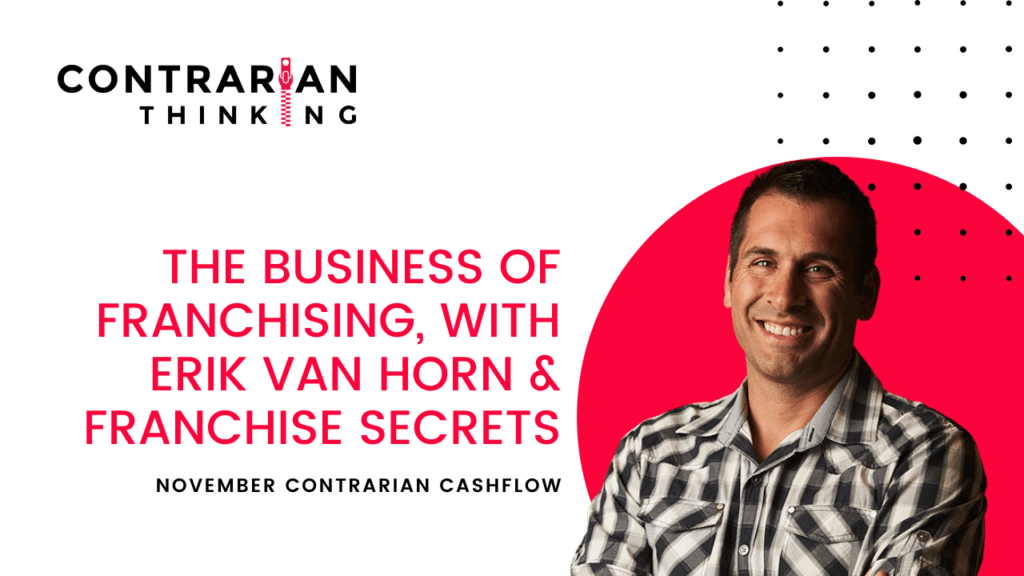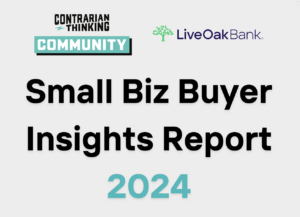Welcome to your November Playbook

Episode 10 – The skinny on franchising & how to play it.
There are many ways to reach financial freedom. We talk about a lot here at Contrarian Cashflow and while this particular path gets a bad rep (mostly from me) we talked to multiple people this month who’ve made it work for them. So maybe I’ll jump in?
A Review of the Opportunity
Becoming a franchise owner is appealing to business owners for many reasons. There’s corporate support and greater resources than the typical start-up, you don’t have to start the business from scratch while inventing business operations along the way. You can potentially develop business quicker by leveraging an established brand name and operating under a proven system with a successful track record. And you can do this all within a plug-and-play structure.
Shaq, Phil Mickelson, and Magic Johnson all used franchises as a springboard to build wealth beyond what they earned during their career in sports. Luckily for you, dunking a basketball or winning The Masters golf tournament isn’t a requirement for building your own ‘Hall of Fame’ worthy business portfolio.
Statistically speaking, franchises will grow 16% this year to a $780bil output and employ 8.25 million people. There’s lots of room in this here opportunity.

Erik Von Horn bought Liberty tax at 24 from the profits of flipping houses. He grew that to 40 locations, sold, and started many other brands whilst consulting on franchises to reach the 100m+ mark. We sat down with him this month to grab some insider info.


Playbook
Before you grab the oversized scissors and cut the ribbon at your location as a newly minted franchise owner, you’ll need to complete a bit of behind-the-scenes work. Let’s break it down.
Step 1 – Self Evaluation
Deciding to own a franchise is a big decision and requires a significant financial, emotional, and physical commitment. Before you go pen to paper, ask yourself some questions and honestly assess if owning a franchise is really for you.
- Do you want to own a franchise or be a business owner? Owning a franchise means buying a system that you operate versus owning your own business and having the freedom to operate it your way.
- Why do you want to own a franchise? Do you want to replace your current income or supplement your current income? Is this a side hustle or vehicle to build significant wealth?
- Will you be an absentee owner or active in the business? What kind of industry interests you?
- Know your financial situation. Most franchisors have net worth and liquid requirements. Do you have enough capital for upfront costs? Can you qualify for a large enough loan if needed?
Net worth is a huge component. Calculate Net worth at this calculator.
- Buying an existing location versus a new one. An existing location with established customers and profits could increase your odds of success. A new location has a higher risk because there are no customers or profits but you may be able to lock down a better location with more upside.
- Know thyself. Are the rewards worth the lifestyle changes that may occur? Would you work evenings and weekends if needed? What skills do you have?
- What is your exit strategy? Do you plan to hold as long as possible and/or pass on to a family member or are there circumstances (personal or financial) where you would sell?
What to see what else is for you? Take this quick quiz at franchisehelp.com.
Step 2 – Selecting a Franchise
The more research you do about which franchise opportunity you want to pursue, the better your chances are of becoming a success.
One of the beautiful things about franchising is there are opportunities for entrepreneurs at all financial levels. You don’t need to be made of gold (although a franchise with the golden arches will cost you low seven figures) with some opportunities requiring a minimum of $20,000 or less.
To whittle down that list of industries and find available franchises within them, visit a website such as the International Franchise Association, Franchise Opportunities, Franchising.com, or Franchise Direct.
If you already know which brand you’d like to partner with, go directly to its corporate website and look for the franchise section.
The information that will guide you with this decision should include, but not be limited to:
- Know your budget – Find a franchise that leaves you with enough operating capital after paying initial fees and startup costs to grow without overextending yourself.
- Financial need vs want – Identify the minimum profit you need to make at your location to pay your bills and maintain your quality of life and the amount of money you WANT to make. Then, search for a franchise where an average-performing location would allow you to hit your income target.
- Know your no – Start with what you know you don’t want in your franchise (time requirements, certain industries, types of employees, etc.) to cut down the list of options and find what you do want.
- Match Game – Identify your top skills and things you enjoy about business, so you can align your franchise with your skills and maximize your odds of success. However, you can also hire people that have the skills your business needs but you don’t have.
Other things to consider when researching a franchise are the strength of the industry, company history and management team, market competition, customer demographics, market demand, number of locations opened and closed the last three years, scalability, minimum financial commitment, and estimated annual return on investment.
Also, examine your geographic and demographic area. College town? A fitness or fast food franchise might do better than a tax or auto shop. General region speakers volumes too:
This process can seem especially overwhelming if you’re a beginner, so you may want to use a franchise broker or consultant to help you identify the right opportunity and walk you through the other steps.
If you already know you’d like to work with a franchise consultant, you can work with someone like Erik, or Franchise Consulting Group.
Step 3 – Contact franchisor and begin the application process
Contact the franchisors you’re interested in and request preliminary information about the franchise along with the steps that are involved in purchasing one. Can also normally just submit your inquiry online, like you can for Crumbl. If a franchise is listed for sale in a new territory you will be dealing first with the broker. Make sure you are provided with a Franchise Disclosure Document (FDD), usually step two after the prelim call, which is a required legal document that defines the relationship between the franchisee and the franchisor. Also request a franchisee questionnaire, which will be reviewed by the franchisor during your approval process.
Questions for the franchisor:
- How did franchises get started/mission?
- Experience/tenure of leadership team
- Their criteria for choosing a franchisee
- How many active locations, failure rate
- Why should I choose this franchise over a competitor?
- Competitive advantages
- What is my territory and how is it protected (protected area)?
- How do they support franchise owners?
- Expenses that are covered by the start-up fees (rent, staffing)
- What additional resources are available if the location business struggles?
- Future plans for the company
Scaling is the path to big profits and financial freedom, so make sure you can replicate this model with more stores. Do you need to acquire territory rights? Is there a limit to the number of stores you can own? Is there a cap on the percentage of locations not owned by the franchisee, or the rate of growth of their brand or number of locations in a given area? All of these factors can limit your upside.
Step 4 – Review the FDD
Reviewing the FDD should be the most important step in this process, as this is when you can really dig into the nuts and bolts of what these opportunities have to offer. The FDD helps you understand the franchise’s business model, fees, and range of financial commitments, plus all financial outlooks, projections, etc.
This document can easily be a couple of hundred pages, so go through this information slowly and carefully. A franchise attorney may be helpful with reviewing the FDD and understanding the legalese and commitment you are making.
Information contained within the FDD includes:
- Franchise fee
- Start-up costs
- Royalties
- Working capital
- Liquidity requirements
- Legal & accounting fees
- Build-out costs
- Marketing/advertising strategy & expenses
- Suppliers & inventory costs
- Training
- Monthly & annual projected revenue
- Executive and management team
- Prior lawsuits and outcomes
- Item 19 – financials showing P&Ls for locations or average unit volume of sales
Here are two examples of FDDs, one from a small company and one from a large company, so you can see what to expect: Broadway Pizza Conrad Hotels & Resorts
The gold standard these days is Crumbl cookies. With buy-in near half a million for most areas, their FDD is expensive and all-encompassing. Here’s their FDD.
Step 5 – Contact other Franchise Owners
Also included in the FDD is a list of contact info for other franchise owners. During this step, you’ll want to reach out and ask questions to get a good idea of what being a franchise owner is all about. Here is an in-depth article on how to approach a franchise owner. This step is key. Talk to as many as you can. They’ll give you the skinny. Erik gave us a resource of 100 questions you could potentially ask.
Some of the questions you should ask are:
- Why did they choose this franchise?
- Would they make that same decision again?
- Ask if they would be comfortable hearing any financial info and if so, what?
- What is their target average cost of goods?
- What are good labor costs?
- What would you consider a great profit margin, decent profit margin, and bad profit margin?
- What is the franchisor good at?
- What is the franchisor’s biggest weakness?
- How effective is their marketing plan?
- What is their biggest frustration as a franchise owner and how did they overcome it?
- Was the franchisee training adequate?
- What is a typical day like?
If you like what you see and hear, apply. You may be required to provide proof that your partnership will be a good fit, with some companies having an extensive list of requirements you will need to satisfy.
Step 6 – Get Funding
Financing here is somewhat limited. While you might have enough cash to fund this franchise, funding through a loan, investor, or home equity line of credit may be a better option… or partnering to secure OPM. There are no seller financing options with franchising and fees are typically non-negotiable. However, for financial help, you can investigate these avenues:
SBA – A loan from the Small Business Association (SBA) if needed, like the 7(a). Terms are typically favorable, but you have to review the FDD to see if your franchise is even eligible for an SBA loan.
Retirement rollovers – tax-deferred, penalty-free means of securing business funding from rolling over funds in your retirement account.
Unsecured loan – this is a securities-based lending option allowing you to borrow against your portfolio without liquidating your holdings.
Personal loans – debt financing through a local bank or credit union for the financing of your business purchase.
Equipment lease – if your franchise is equipment heavy, you can finance up to $2mil worth of equipment with no personal collateral on the line.
Step 7 – Breakdown the finances & build projections
A good thing with franchises is that a general P&L template is already built for you. Your upfront costs will normally look like this.
The FDD for your franchise will include your expenses on an ongoing basis as well as the royalties and other fees. You need to add an account for your financing repayment and upfront capital deployed to determine break-even and profitability terms. Once you’re operating and getting a feel for your real sales/revenue, you can more closely project.
Want to scale? We have an entire cash flow projection model that can handle building out up to 12 locations over 10 years. Plug and play.
Step 8 -Sign the Franchise Agreement
Signing the franchise agreement is the equivalent of standing at the business altar and saying “I do,” as this document makes the new relationship official. So, before you repeatedly scribble your name or initials on a contract, you should consult with a franchise attorney who specializes in reviewing these documents and can explain the legalese to you.
While many franchisors have rigid franchise agreements, some may be more flexible about negotiating terms in the agreement. If the franchisor is willing to negotiate certain terms, your attorney can help find the best solutions for your situation.
If the franchise agreement is rigid, that isn’t a cause for concern. Remember, franchises are based upon a proven system and consistency of the brand. Conversely, if the franchise agreement for the brand you chose is overly negotiable, it could be cause for deeper investigation.
If everything looks good, sign the franchise agreement and be ready to write out the first of what may feel like many checks for the initial franchise fee. Be clear on what this payment covers and what additional fees may follow.
Step 9 – Find a Location
If you’re starting from scratch…location, location, location – it’s the golden rule in real estate and business, so finding the best home for your franchise is imperative. Now is the time to review the information about the franchisor site requirements in the FDD and franchise agreement and seek out a competitive location to submit for franchisor approval.
Seek a high-traffic area with complementary businesses and limited, or no, competition nearby to attract customers. Most franchisors will assist you with site selection. Remember, they want to see you succeed as much as you do.
In many cases, the franchisor will have to approve your location before you can move forward. Once approved, sign a lease and begin developing the location. Be clear on design specifications for your franchise before you begin work as many franchises have specific requirements.
If you’re buying an existing business from a previous franchisee, location and real estate are already included in costs and determined for you.
Step 10 – Training
You will be required to attend franchise training and learn the ins and outs of how to run your franchise to the standards as laid out by the business model. Expect to travel to the franchise’s headquarters for training which can last anywhere from a few days to a few weeks, so be sure to make the necessary arrangements. Remember what we said earlier about understanding what your up-front fee covers? Well, the franchise fee generally covers the cost of the training courses, but you’re typically on your own for travel expenses ranging from tanks of gas to plane tickets. Factor in these costs. Training is also ongoing. So expect multiple times per year.
Step 11 – Hiring/Prep/Grand Opening
We’re almost at the finish line – or the starting line, as after you finish training, it’s time to finish the build-out on your new franchise location and make sure everything is equipped and operating correctly.
You’ll also begin hiring and training your staff, obtaining permits, and getting insurance. Two good websites to use as a reference to what permits and insurance might be necessary are the Small Business Administration and FindLaw. The FDD should also spell these out.
Franchisors have a more sophisticated marketing plan than that and will often have defined processes for signage, ads, and other promotional strategies to support your opening.
These two articles should get your wheels spinning with ideas for making a splash with your grand opening.
Some franchisors will do a ‘soft opening’ before the ‘grand opening’. A soft opening allows you to smooth out any initial bumps within the operation of the business before the big marketing blitz, and hopefully larger crowds that will come with the grand opening. Some franchisors also provide a corporate trainer during these early days to assist once the doors swing open for the very first time.

Tips + Tricks
Let’s go above and beyond with some more considerations.
- You might have less creative freedom or decisions on any new revenue streams or profit lines within your franchise, but sometimes you are able to get creative with marketing, promoting, and social media for your location. Your FDD might come with additional recurring fees to cover training on updates for marketing but to increase location sales, there’s extra you can do.
- Understand your competition
- Write your own marketing plan
- Hire social media and digital marketing help
- Make relationships with media outlets in your area
By far the biggest difference here are the kinds of fees: initial and recurring royalties.
- Initial: One time. Your admission into the franchise granting you the permission to operate. Includes some startup costs, support, and documentation. Can be between $20k-$100k depending on the size of your franchise.
- Royalties: Ongoing. These are the %s of sales you pay monthly to continue using the brand name, ongoing training, operating SOPs, consulting, software, and support. Average royalty fees – 4%-9% with some as high as 13%.
- Additional fees: Ongoing. Can come in the form of advertising and marketing fees for the franchisor to help with this aspect of your business. Normally between 2%-3% of gross sales.
And guess what…one downfall? No negotiation on fees. And if you can’t pay them going forward, you and your franchise are subject to legal action and potential termination.

AMA
This month we’re going panel style again. We have not 1, not 2, but 3 franchise experts who’ve taken their franchise experience to 8 figures. Join us on Dec 6th at 10 am CT for the Q&A. It will be recorded and stored in the vault.
Also, our monthly community meeting time has been MOVED earlier. We’ll be chatting together on Tuesday, November 30th at 3 pm CST.
Prove me wrong with successful franchising!
Codie
Disclaimer – This is the “Be an adult” section. Everything mentioned above isn’t advice, just a recount of what I did. That said: This article is presented for informational purposes only. The opinions stated here are not intended to recommend any investment or provide tax advice. Neither are they an offer to sell or the solicitation of an offer to purchase an interest in any current or future investment vehicle managed or sponsored by Codie Ventures, LLC or its affiliates. All material presented in this newsletter is not to be regarded as investment advice, but for general informational purposes only. Day trading and investing do involve risk, so caution must always be utilized. We cannot guarantee profits or freedom from loss. You assume the entire cost and risk. You are solely responsible for making your own investment decisions. We recommend consulting with a registered investment advisor, broker-dealer, and/or financial advisor. If you choose to invest with or without seeking advice from such an advisor or entity, then any consequences resulting from your investments are your sole responsibility. By reading/sharing this newsletter or consuming our content on our other channels, you are indicating your consent and agreement to our disclaimer.





